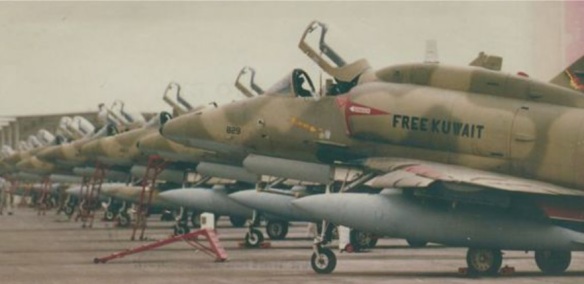The Free Kuwait Air Force was an air force in exile. During Operation Desert Storm, flying nearly 1,400 sorties for one loss. Most of their missions were over Kuwait itself.
A Free Kuwait Air Force A-4KU, armed with 500lb ‘Snakeye’ bombs.
In the early morning of 2 August 1990 Iraqi forces crossed the Kuwaiti border and headed for Kuwait City and the country’s main military bases. Details of the chaos that followed and the valiant efforts of the defenders to hold back the Iraqis have received little recognition. More air combat took place during the invasion than is usually appreciated. Although the Kuwaiti military were not on a state of alert, many of the Air Force’s jets managed to get airborne and encountered Iraqi helicopters at low level over Kuwait City. The pilots of six Mirage F1CK fighters (flown by Nos 18 and 61 Squadrons) claimed the destruction of thirteen Iraqi helicopters between them, mainly Mi-8 ‘Hip’ and SA.330 Puma transports. Using R.550 Magic missiles and 30mm cannon, they shot down some of the heavily laden helicopters as they tried to evade between the buildings and others that tried to escape having dropped off their contingents of special forces troops. One source also says that they also destroyed one MiG-21 and an 11-76 jet transport. The A-4s and the Hawk Mk.61 trainers of No. 12 Squadron attacked Iraq’s armed helicopters (Mi-8s, but possibly also Mi-25 ‘Hinds’) over the city with cannon, and the Skyhawks claimed five kills. Three of these were confirmed, the victorious pilots being Hassan al-Qattan, Ala’a al-Sayegh and Adnan Abdul Rasool. Stories have circulated since 1990 that Skyhawks destroyed airborne Iraqi helicopters with cannon, Sidewinders and even a 5001b bomb. The use of bombs in the air-to-air role is known to have been discussed with the KAF’s American advisors before the war.
Later in the day A-4KUs encountered Iraqi Mig-29s and Mirage FIs, which appeared too late to protect the assault helicopters, but there was no aerial combat between them. Subsequently the A-4s attacked columns of advancing Iraqi troops by day and by night until al-Jabr was overrun. Some missions were said to have been flown from the highway beside the base, which was so narrow that at least two A-4s ran off into the desert while landing but were recovered without damage. It is more likely that the location was the al Abdaliyah highway strip situated to the north west of al-Jabr. Eventually, out of ammunition and low on fuel, the surviving Skyhawks flew to Bahrain on 4 August.
During the Desert Shield build-up to the Gulf War itself, the surviving A-4s and the Mirages were reorganized as the ‘Free Kuwait Air Force’ and based at Dhahran, Saudi Arabia, where they were maintained by US civilian contractors.
The A-4KUs were notionally Maverick capable but were never equipped with these missiles in service. Known weapons used include Mk 7 cluster bomb dispensers and Mk 82 5001b Snakeye bombs with and without ‘daisy cutter’ fuse extenders. Patriotic slogans such as ‘To Saddam With Love’ and ‘Remember Kuwait’ were sometimes painted on the bombs and dispensers in Arabic. At least one was seen with TERs on the outer pylons carrying ADSID (Air-Delivered Seismic Intrusion Detectors) sensors, as well as a load of Mk 82s on the centreline. ADSID consisted of spike-shaped devices that were dropped in an area where enemy forces might infiltrate. They would transmit a signal when they detected the noise or vibration caused by troops and vehicles. ADSID was used on the A-4s at the request of the US Marines, whose nearest ADSID-capable aircraft were Harriers based in Bahrain, but who wanted to monitor an area of Kuwait.
By the end of September 1990, the airworthy Kuwaiti A-4s were gathered at Khamis Mushait AB in Southern Saudi Arabia for a period of training. In November they were sent to Dharhan alongside other coalition aircraft, including RAF Tornadoes. In the period of Operation Desert Shield up to 16 January 1991, the Kuwaiti A- 4s flew a total of 258 ‘operational’ and 427 support sorties – although what the former were and the actual distinction between the two is unclear.
The Free Kuwait A-4s flew their first mission against Iraqi forces on the morning of 17 January 1991, the first day of operation Desert Storm. The mission went badly and it is said that ten of the eleven A-4s involved dropped their bombs on Saudi territory in error. The eleventh, flown by the squadron commander, Lieutenant Colonel Muhammed Sultan Mubarak, was shot down at 1030 local time twenty-five nautical miles south of Kuwait City by a radarguided SAM. The location suggests he was attacking his own former base at al-Jabr. Mubarak ejected and was made a prisoner of war and appeared on Iraqi TV three days later. He was not released by 6 March 1991 with the bulk of Coalition prisoners, but is believed to have been freed later.
Published figures say that the twenty-four Free Kuwait A-4s flew 651 missions or 1,361 individual sorties during Desert Storm. After the liberation of Kuwait in February 1991, the A-4s were put into storage pending the delivery of F/A-18Cs and Ds that had been ordered prior to August 1990. Eventually the majority were sold to Brazil.
